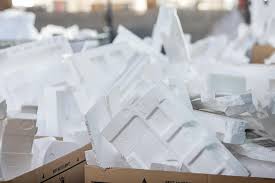Styrofoam, also known as expanded polystyrene (EPS), is a lightweight, foam-like plastic commonly used in packaging, insulation, and disposable food containers. While it is a convenient material, Styrofoam poses significant challenges for waste management due to its bulky nature and environmental impact. This article explores whether Styrofoam can be recycled, how the recycling process works, and practical tips for managing Styrofoam waste responsibly.
What is Styrofoam?
Styrofoam is a trademarked form of expanded polystyrene foam. It is composed of about 90-98% air, making it very lightweight but bulky. This structure gives it excellent insulation and shock-absorbing properties, which is why it is widely used for packaging electronics, appliances, and food containers. However, its lightweight and bulky nature also make it difficult to handle in waste management systems76.
Can You Recycle Styrofoam?
The short answer is: yes, Styrofoam can be recycled, but not through regular curbside recycling programs in most places. The material is technically recyclable, but its low density means it takes up a lot of space, making it inefficient and costly to collect and process in standard recycling facilities67.
Why is Styrofoam Recycling Difficult?
- Bulkiness and Low Density: Since Styrofoam is mostly air, it occupies a large volume relative to its weight. This means it quickly fills up recycling bins and trucks, reducing the efficiency of collection systems67.
- Contamination: Styrofoam used for food containers often has food residue, which can contaminate recycling streams if not properly cleaned5.
- Lack of Facilities: Many local recycling programs do not accept Styrofoam because specialized equipment is needed to process it, and not all communities have access to these facilities15.
How is Styrofoam Recycled?
When Styrofoam is recycled, it undergoes a specialized process:
- Collection and Sorting: Styrofoam is collected separately from other recyclables. It must be clean and free of contaminants like food waste, tape, or labels57.
- Shredding: The Styrofoam is shredded into smaller pieces to reduce its volume47.
- Densification: The shredded material is then compressed or melted to form dense blocks or ingots, reducing volume by up to 90:1. This makes storage and transportation more efficient47.
- Reprocessing: The compressed Styrofoam blocks are then ground into pellets that can be used to manufacture new products such as picture frames, insulation boards, hangers, and other household items97.
This process requires specialized machinery like foam densifiers and compactors, which are not commonly available at standard recycling centers79.
Where Can You Recycle Styrofoam?
Because of the challenges involved, recycling Styrofoam often requires finding specialized recycling centers or drop-off locations:
- Specialized Recycling Facilities: Some companies and recycling centers specialize in processing Styrofoam. You can search online or contact your local waste management authority to find these facilities near you17.
- Retail and Shipping Stores: Certain shipping stores accept Styrofoam packing peanuts for reuse or recycling6.
- Community Recycling Events: Some communities organize special collection days for materials like Styrofoam, providing residents with an opportunity to recycle it properly5.
- Mail-Back Programs: A few companies offer mail-back recycling programs where you can send your Styrofoam waste for recycling2.
Before recycling, always check with your local recycling program to confirm whether they accept Styrofoam and what preparation steps are required5.
What to Do If You Can’t Recycle Styrofoam?
If recycling options are not available, consider these alternatives:
- Reuse: Styrofoam containers and packaging can be reused for storage, crafts, or as packing material for shipping15.
- Reduce Usage: Avoid purchasing products with Styrofoam packaging when possible and opt for alternatives like paper or biodegradable materials.
- Proper Disposal: If you must dispose of Styrofoam, make sure it is clean and dry before placing it in the trash to minimize contamination and environmental harm6.
Environmental Impact of Styrofoam Waste
Styrofoam is not biodegradable and can persist in the environment for hundreds of years. When discarded improperly, it can break into small pieces that pollute waterways, harm wildlife, and contribute to landfill overcrowding59. Recycling Styrofoam helps reduce these impacts by diverting waste from landfills and turning it into useful products.
Summary Table: Styrofoam Recycling Overview
| Aspect | Details |
| Material | Expanded Polystyrene (EPS), 90-98% air |
| Common Uses | Packaging, insulation, food containers |
| Can it be recycled? | Yes, but not in most curbside programs |
| Recycling Challenges | Bulky, low density, contamination, lack of facilities |
| Recycling Process | Collection → Shredding → Densification → Pelletizing → New products |
| Where to Recycle | Specialized centers, shipping stores, community events, mail-back programs |
| Alternatives if no recycling | Reuse, reduce usage, proper disposal |
| Environmental Concern | Non-biodegradable, pollutes land and water, harms wildlife |
Final Thoughts
Recycling Styrofoam is possible and important for reducing environmental harm, but it requires awareness and effort from both individuals and communities. By cleaning and sorting Styrofoam waste and seeking out specialized recycling options, you can help keep this material out of landfills and support a circular economy. When recycling isn’t an option, reusing Styrofoam or reducing its use are practical ways to minimize its impact.
Taking these steps ensures that Styrofoam waste is managed responsibly, protecting the environment and conserving resources for future generations.
For more detailed guidance on recycling Styrofoam and finding local recycling centers, you can visit resources like ACTenviro, BEWI, and INTCO Recycling, which provide comprehensive information and solutions for Styrofoam waste management147.

